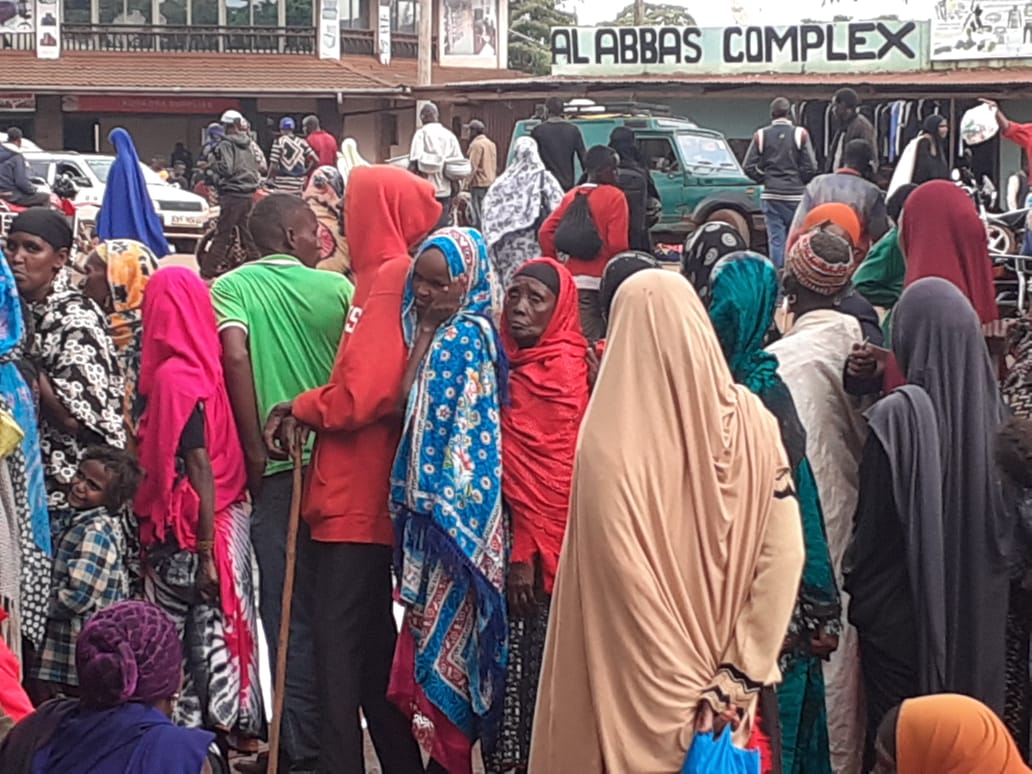 Beneficiaries queue for payment in MarsabitHSNP has delivered Kshs 0.54 billion (£3.99million) to 97,967 households (Appr. 600,000 people) across the four arid counties of Turkana, Mandera, Wajir and Marsabit. This second tranche, referred to as KR2, was paid out on November 25, 2019. The first tranche of regular cash transfer for this financial year was paid in July
Beneficiaries queue for payment in MarsabitHSNP has delivered Kshs 0.54 billion (£3.99million) to 97,967 households (Appr. 600,000 people) across the four arid counties of Turkana, Mandera, Wajir and Marsabit. This second tranche, referred to as KR2, was paid out on November 25, 2019. The first tranche of regular cash transfer for this financial year was paid in July
Implemented by the National Drought Management Authority, HSNP is an unconditional flagship cash transfer programme that delivers social assistance cash transfers to poorest and most vulnerable households with an aim of reducing extreme poverty and hunger.
The programme is funded by GoK through a credit facility of the World Bank and a grant from UKAid under the umbrella of the Kenya Social and Economic Inclusion Programme (KSEIP).
Under cycle KR2, 21,736 households were paid a total of Ksh119,254,800 while in Marsabit, some 19901 households were paid Ksh109,791,000. In Turkana county, 37,592 households received Ksh209,111,400 while in Wajir, 18738 households got Ksh103,735,800. Chart
Chart
By yesterday morning, scores of beneficiaries had lined up at various pay points after the programme delivered the pay message through a network of chiefs, SMS and radio alerts as part of the beneficiary outreach strategy. There were queues at Equity Bank branches and agencies across the four counties but NDMA officers and Equity Bank personnel ensured that every beneficiary on the queue was paid. Each beneficiary was paid Ksh5400 which is the minimum per payment cycle. There are pay points within a radius of 10km for a beneficiary.
The cash transfers are delivered in two-fold: 1) regular bimonthly to 101,800 Group 1 considered the poorest under the poverty ranking 2) drought emergency scale-up to additional households, Group 2.
Feedback from HSNP households disclosed that the bulk of the cash goes towards buying food for household consumption. Further, HSNP cash enables the households’ to increase the frequency and portions of meals per day as compared to non-HSNP households.
On payday, many beneficiaries buy “bulk” quantities of stables that include: cooking oil, beans, rice, spices, tea leaves, maize and maize flour and this is reflected by the vibrancy of local markets. HSNP cash transfers also assist the households to improve on dietary diversity, as they are able to buy “luxury” items like meat and vegetables in small quantities. Further, the households are able to buy milk for a longer period for daily consumption thus meeting the nutritional requirements of vulnerable household members like children and the elderly.
HSNP cash is also used to re-pay credit and has increased the “credit-worthiness” of the beneficiaries as it enhances the ability to borrow from friends, neighbors and local traders. The ability to access credit is important for consumption smoothing effects. Households can access food and other essential household items on credit as they wait for the next payment. Beneficiaries also use a portion of HSNP cash to pay school fees and meet educational costs (uniforms, shoes, books, school supplies, exam fees) thus improving access to education for children from the poorest households and especially orphans and children of widows. Additionally, feedback from respondents that include teachers reveals that children from HSNP households recorded high school attendance, as they were less likely to engage in child labour. HSNP cash reduces the pressure of households to engage their children in income-generating activities.
There are beneficiaries that share that they use HSNP cash for home improvement such as improvement of house structure e.g. roofing with corrugated metal sheets, cement for flooring and constructing additional rooms. Others purchase of household items such as utensils, stools, and beddings. There are a few beneficiaries that are able to save a portion of their cash over a period of time to buy small livestock mostly sheep and goats. The ability to buy and maintain assets in the form of livestock remains an important issue across the four counties where forms of pastoralism are the main source of livelihood.
A quick analysis of the use of HSNP cash transfers by the beneficiaries indicates that the programme is supporting the realisation of the socio-economic empowerment of the poorest and vulnerable people as specified under the social pillar of Vision 2030. One of the flagship projects under the social pillar is the establishment of a consolidated social protection fund implemented through the National Safety Net Programme (NSNP) that has four National cash transfer programmes including HSNP. The aim of NSNP is to boost economic empowerment of vulnerable groups through social assistance cash transfers.
